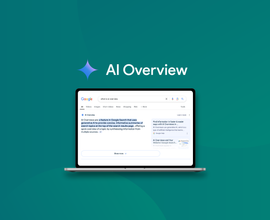Your Guide to Customer-First Marketing [Infographic]
Struggling to implement a customer-first marketing strategy? Follow this guide to build out your own personalized customer-first marketing efforts.
Do you understand your customers’ needs? Every marketer wants to attract and convert customers, but you can’t do that unless you truly know what they need.
From developing a new product to publishing a piece of content, every business decision should be driven by the desires of the customer. Without doing so, you risk falling flat.
66% of customers expect companies to understand their needs. You’re expected to accommodate the preferences and expectations of the customer. This doesn’t leave much wiggle room for your marketing strategy to fail.
If you want to deliver a great customer experience, then you need to fulfill the needs of your target audience with a customer-first marketing strategy.
What is customer-first marketing?
Customer-first marketing is a strategy by which businesses create products, content, and marketing campaigns so that their primary purpose is putting their customers first and their organization second. That customer focus represents a significant change from traditional marketing strategy, which focused on creating marketing initiatives based on company needs instead of customer needs.
What does it mean to put customers first?
To be truly customer-first, businesses need to do more than just talk the talk. They need to rebuild their organization around a single-minded focus on the customer and how their organization can make a positive impact on their customers’ lives.
Seek customer feedback
In Tricia Wang’s TED talk, “The human insights missing from big data ,” she explains that the $122B big data industry means nothing without qualitative human insights.
Customer-first businesses don’t hesitate to seek out customer feedback and use it to inform their business actions, from product roadmaps to marketing and beyond. Through this responsive feedback loop, businesses can successfully discover, understand, and meet their customers’ needs early and often.
Gather customer insights
Collecting customer insights should be a company-wide initiative and a regularly occurring priority, but often marketing teams are at the forefront of the drive to put customers first.
Here are seven ways to gather insights from your customers:
- Surveys
- Reviews
- Social media analytics and engagement
- Social listening
- A/B testing of your products/services
- Contact/support messages
- Chatbots
How can you introduce your team to customer-first marketing?
Taking on customer-first marketing is no easy feat—but it’s important. To support your efforts, we’ve laid out a plan for how to kickstart your customer-first strategy in this guide.

Not a visual learner? Here’s the plain text guide
If you only create outbound marketing, you’ll miss an even bigger opportunity to give value to your customer when they’re actively searching for answers. Billions of people are searching for your solutions every year—will they find you?
Customers have gone from captive to empowered
Customers have gone from captive to empowered. Marketers are facing a new generation of customers who are empowered to skip ads or content that doesn’t solve their problems.
Customers don’t look for a business—they look for solutions. They will find you if you provide value.
Traditional marketing asks the questions:
- Who can we sell our products to?
- How do we convince people to buy?
- How can we get them to buy again?
Customer-first marketing asks the questions:
- What problems do we solve?
- Who has these problems?
- How will customers find our solutions?
How to empower your customers
Customer empowerment means providing your customers with the information they need to make a decision about what you’re offering.
By helping them, you’re providing a good customer experience with your brand. Here are six ways to do this:
- Save them time by making things easy
- Listen to their concerns
- Create educational content
- Allow them to leave reviews or provide feedback
- Connect with them on social media
- Provide great customer service
Customers want value
Customers want you to provide relevant information to help solve their problems. They want your help in making a decision. And they want 24/7 support through all stages of their purchase journey.
“We need to stop interrupting what people are interested in and be what people are interested in.” – Craig Davis, Former Chief Creative Officer at J. Walter Thompson Worldwide
The only algorithm that matters is the heart and mind of your customer. Google’s algorithm is simple: it strives to surface content that provides relevant, timely value and the best user experience for people who are searching.
If you focus on building content that matches your customers’ intent across the purchase journey, you won’t need to spend another day thinking about what Google might do next.
Simple, one-word changes can help you reach your customers. Your audience is already telling you what they want—you just need to listen.
We can’t have a marketing program without customer insights. We need to intimately understand them. We can’t be self-serving. We have to serve our customer.
What are the benefits of customer-first marketing?
Successful businesses take steps to meet customer needs early and often. Ensuring that customer needs are met helps you align with other teams at your organization—sales, customer support team, product, etc.
With your organization operating under a cyclical process of anticipating, identifying, and meeting customer needs, you’ll soon see results. To motivate you to get there, here are four benefits to consider:
- Customers will become loyal
- You’ll generate more sales
- Customers will refer friends and colleagues to you
- Feedback helps you improve your business
What are the implications of marketing using the voice of the customer?
The voice of the customer is your customer’s feedback about their experience with your brand and its products or services.
Using the voice of the customer in your marketing efforts helps you connect with the audience. It improves the customer’s experience with you.
By listening to the voice of the customer, you can understand and then meet the customer’s needs. A marketing program that’s focused on the customer’s voice provides you with insight into customer preferences, problems, and even ideas. You’ll be in position to identify problems and opportunities so you can work to improve your offerings.
So, how do you do customer-first marketing?
- Identify opportunities to solve problems for your customers.
- Create or modify content to address gaps where your customers are searching but aren’t finding you.
- Empower multiple teams in your org to make better decisions with customer data.
What does it mean to speak using the voice of the customer?
You’ve likely heard the phrase, “You’re speaking my language.” Speaking like your customers (i.e., the voice of the customer) when crafting any type of messaging helps to keep them on your site, continuing to read your content and explore what you have to offer. You become more relatable and accessible to the very people you’re trying to reach.
By getting involved (both online and in-person) with your audience, you’re gaining an understanding of the people whose voice you want to emulate.
Note how casual or formal your customers are when engaging with you. What common phrases do they use? How do they talk about your products and services? If you want your content to resonate with readers and turn them into loyal customers, you need to speak using their voice.
Customer voice helps the customer relate to your content
Think about the last time a piece of content left you feeling like it was created just for you. Did the author speak like you? Did you feel a connection?
Your audience will relate to your content when you understand their needs and how they speak. By using the customer’s voice to connect the reader to you on an emotional level, you’ll see that relatability is one of the most important tools in content marketingContent Marketing
Content marketing is a marketing discipline with the goal of increasing awareness and scope for products and brands in the desired target group with content published on the web and offline.
Learn more.
Customer voice makes it easier for customers to find you
Put yourself in your customer’s shoes. It’s your responsibility to understand them and what they find engaging or helpful. By creating content that speaks to them, you’re making it easier for the right audience to find you.
Here’s a tip for coming up with content ideas based on the voice of the customer. Google Search Console is a free tool that shows you exactly which queries are bringing users to your site. You might find that certain questions are commonly searched, or maybe they’re using terminology you haven’t considered yet.
By using the customer’s voice in conjunction with SEO best practices for content, your website is more likely to show up and rank in search results for the terms and phrases they’re searching on.
So, how do you do customer-first marketing?
- Identify opportunities to solve problems for your customers.
- Create or modify content to address gaps where your customers are searching but aren’t finding you.
- Empower multiple teams in your org to make better decisions with customer data.

![Brendan Anderson, VP of Marketing, [object Object]](https://cdn.sanity.io/images/tkl0o0xu/production/6904541bb2ba740eca5202c13219c32001c5de9e-1765x1765.png?fit=min&w=100&h=100&dpr=1&q=95)






